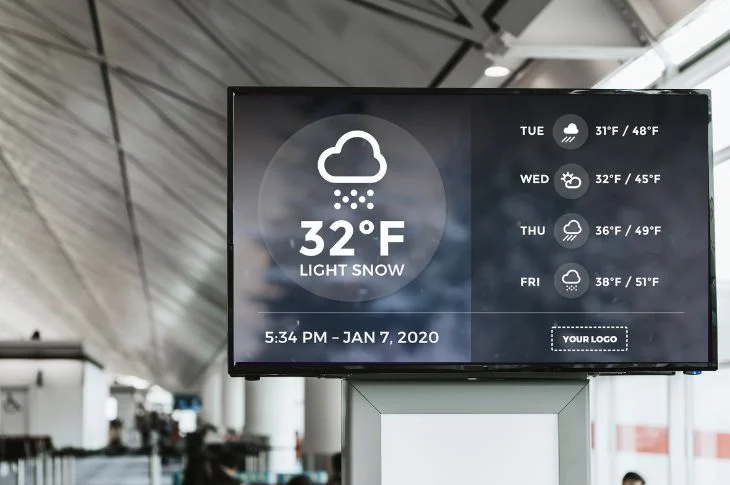Digital display signage has revolutionized the advertising industry by offering businesses a dynamic and engaging way to promote their products and services. With the ability to display rich multimedia content in real-time, digital signage has become a popular tool for advertisers looking to capture the attention of consumers. However, while digital display signage offers many advantages, there are significant challenges that come with using it for advertising, particularly when it comes to profitability and managing the logistics of ad placements.
In this article, we’ll explore some of the key challenges that advertisers and business owners face when using digital display signage for advertising purposes.
1. High Initial Costs and Long ROI Timelines
One of the most significant challenges of digital display signage is the high upfront cost of purchasing and installing the displays. Whether it’s a small screen in a retail store or a large 55-inch display, the initial investment can be substantial. Advertisers often prefer large screens, such as 55-inch digital displays, because they have a higher impact on viewers and are more likely to be noticed. However, if you don’t offer at least a 55-inch digital display signage, you may struggle to attract high-paying advertisers, and this can significantly reduce your potential revenue.
Unfortunately, it usually takes years to recoup the initial investment in digital display signage, as the revenue generated from ads may not cover the costs for a long time. This long return on investment (ROI) timeline is a major hurdle for businesses that need quicker profitability from their advertising efforts. The costs of maintenance, software updates, and content management only add to the financial burden, making it difficult for businesses to break even in a short period.
2. Limited Control Over Advertising Content
Another significant challenge when using digital display signage for advertising is the limited authority business owners or managers have over the ads that are displayed. In many cases, advertisers or third-party advertising agencies control the content, and you may not have much say in which ads are shown on your digital display signage. This lack of control can be frustrating, especially if the ads being displayed don’t align with the values or image of your business.
Moreover, certain advertisers may have strict requirements for the placement and visibility of their ads, limiting your ability to customize content based on the specific audience of your location. For example, if you’re in a retail store, but the ads being displayed are for services unrelated to your target market, it could reduce the effectiveness of your digital display signage and potentially harm your business’s reputation.

3. Finding Advertisers Is a Full-Time Job
For many business owners, another big challenge is that managing digital display signage is not a passive endeavor. Finding advertisers willing to pay for space on your displays can become a full-time job. It often requires active outreach, negotiations, and building relationships with advertising agencies or companies looking for ad space.
In addition, many advertisers are only interested in premium placements on large, highly visible displays. As mentioned earlier, if you aren’t offering 55-inch digital display signage, you may not attract premium advertisers, which can limit your earning potential. Smaller displays or less desirable locations might not be as lucrative, forcing you to work even harder to find enough advertisers to cover your costs.
Managing the contracts, content, and scheduling for multiple advertisers also takes significant time and effort. Without dedicated resources to handle these responsibilities, it’s easy for the advertising operations to become overwhelming and inefficient.
4. Ongoing Maintenance and Software Updates
While digital display signage offers dynamic content display, it also requires ongoing maintenance and updates to keep running smoothly. Unlike traditional static signs, digital displays rely on software and hardware that can break down, experience glitches, or require regular updates. The cost of maintaining the displays, updating software, and fixing any technical issues adds to the overall expense and can eat into the profits generated by the ads.
Furthermore, ensuring that the content is updated in real time to reflect the latest promotions or ad campaigns adds another layer of complexity. If your software isn’t capable of handling quick changes or if there are delays in content delivery, advertisers might not be satisfied, resulting in a loss of contracts or reduced payment.
5. Dealing with Ad Competition
The effectiveness of digital display signage for advertising depends heavily on the visibility of the ads. However, in many environments, there may be multiple displays competing for attention. For example, in a shopping mall or busy city center, consumers are constantly bombarded with ads from various sources, including billboards, online ads, and other digital displays. The competition for consumer attention can make it harder for your digital display signage to stand out.
Advertisers are well aware of this and may be unwilling to pay top dollar for ad space on your digital display signage if they feel that it’s competing with too many other advertisements. This can make it challenging to attract high-paying advertisers, particularly in crowded or competitive spaces.

6. Compliance and Legal Considerations
Another challenge that business owners face when using digital display signage is ensuring that all ads comply with local regulations and legal requirements. Depending on the country or region where your displays are located, there may be specific rules governing advertising content, including restrictions on certain types of products or services (such as tobacco or alcohol).
It’s your responsibility to ensure that the content displayed on your digital display signage is compliant with all relevant laws and regulations. Failure to do so could result in fines or penalties, further cutting into your profits. Staying up-to-date with these regulations and making sure all content complies can be time-consuming and requires attention to detail.
7. Expensive Installation and Hardware Upkeep
One of the biggest challenges when working with digital display signage is the initial investment in hardware and installation. Unlike static billboards or traditional signage, digital displays require a significant financial outlay for both the screens and the infrastructure needed to support them. Whether you’re purchasing a simple 32-inch screen or the more desirable 55-inch digital display signage, the cost of the equipment alone can be prohibitive for small businesses.
However, the spending doesn’t stop at purchasing the hardware. Installation can also come with a high price tag, especially for large or outdoor displays. Setting up a network of digital display signage involves technical expertise, as the signage must be connected to a reliable power source and internet connection. Additionally, if you’re using multiple screens in different locations, each one must be managed separately, which adds to the logistical complexity.
Once installed, the equipment requires regular maintenance. Screens can malfunction, the software may need frequent updates, and any external displays are subject to weather conditions that could damage the hardware over time. The costs of repairs and replacements for digital display signage can quickly add up, further delaying your return on investment.

8. The Struggle to Remain Relevant in a Digital World
In today’s fast-paced world, content quickly becomes outdated, and digital display signage requires constant updates to stay relevant. Advertisers expect their content to be refreshed regularly, which means business owners or signage managers must be prepared to update the displays frequently. Failure to keep the content fresh can lead to diminished interest from viewers, reducing the effectiveness of the advertisements.
Moreover, the rapidly evolving nature of technology means that the hardware used for digital display signage can become obsolete relatively quickly. Newer, more advanced screens with higher resolutions or better integration features are constantly being released, which can make existing displays seem outdated. Advertisers may start looking for newer and more advanced digital display signage platforms if your technology is not up-to-date, further hindering your ability to attract premium advertisers.
9. Challenges in Ad Placement and Scheduling
One of the more nuanced challenges of digital display signage is managing ad placement and scheduling. In many cases, advertisers may want their ads to run during specific times of the day or in specific locations where they expect higher traffic or more engagement. For example, a business advertising breakfast specials might want their ad to run in the morning, while a nightclub may prefer evening hours. This requires intricate planning and scheduling to ensure that the right ads are displayed at the right times.
If you are operating multiple displays in various locations, this can quickly become a logistical nightmare. You’ll need to coordinate with advertisers to meet their scheduling demands, which can require a high level of organization and technical expertise. In addition, managing these schedules takes time and can be prone to errors, which may lead to dissatisfied advertisers if their content is not displayed as promised.
Another factor to consider is the competition for prime time ad slots. If you have multiple advertisers vying for the same time frame, you may need to navigate complex negotiations to ensure that everyone gets their fair share of visibility. This can further complicate the process and lead to tension between advertisers.
10. The Challenge of Measuring Ad Effectiveness
One of the most significant challenges when using digital display signage for advertising is determining the effectiveness of the ads. Unlike online advertising, where clicks and impressions are easily tracked, it can be difficult to measure how many people are actually viewing or engaging with your digital display signage. While you may know how many people pass by your signage each day, that doesn’t necessarily translate to how many people are actively noticing or engaging with the advertisements.
To make matters more complicated, advertisers are often looking for clear metrics to determine their return on investment. Without the ability to track the number of impressions, interactions, or conversions generated by the signage, it becomes harder to prove the value of the ad space. This can make it challenging to justify higher prices for ad placements, especially when dealing with advertisers who are used to the granular data provided by digital platforms like Google Ads or Facebook.
Some businesses are attempting to solve this problem by incorporating advanced analytics tools into their digital display signage systems. These tools can track viewer demographics, engagement times, and even emotional responses through facial recognition technology. However, these systems are expensive and come with their own set of privacy concerns, which may deter advertisers from using them.
11. Navigating the Legal and Regulatory Landscape
While digital display signage offers more flexibility than traditional billboards or print advertisements, it is also subject to strict legal and regulatory guidelines. Depending on where the signage is located, there may be specific rules about what type of content can be displayed, how bright the signage can be, and whether it can include moving images or sound.
For instance, in some cities, digital signage in public spaces may not be allowed to display certain types of advertisements, such as those for alcohol, tobacco, or adult services. Business owners must stay informed about the local regulations governing digital display signage, as failure to comply with these laws could result in hefty fines or even the removal of the signage altogether.
Additionally, there are often zoning restrictions that dictate where digital display signage can be installed. For example, in some residential areas, bright or animated signage may be prohibited to prevent it from disturbing the local residents. Before investing in digital display signage, it’s important to thoroughly research the legal landscape in your area to avoid any costly mistakes.
12. Competing with Online Advertising Platforms
The rise of digital advertising platforms like Google Ads, Facebook, and Instagram has made it harder for traditional advertising methods, including digital display signage, to compete. Online platforms offer advertisers the ability to target their ads with pinpoint precision, track engagement metrics in real time, and easily adjust campaigns based on performance data.
For businesses using digital display signage, it can be difficult to match the level of flexibility and control that online platforms offer. While signage can certainly reach a broad audience in high-traffic areas, it doesn’t offer the same level of targeting or personalization as online ads. This can make it harder to convince advertisers to invest in your digital display signage, especially if they are used to the granularity and cost-effectiveness of online platforms.
Moreover, many online platforms offer automated bidding systems that allow advertisers to control their spending and optimize their campaigns for specific outcomes, such as clicks or conversions. Digital display signage, on the other hand, typically involves a more manual approach to pricing and scheduling, which can be time-consuming and less flexible for advertisers.
13. The Risk of Screen Burn-In and Content Stagnation
One of the technical challenges associated with digital display signage is the risk of screen burn-in. Burn-in occurs when a static image is displayed on the screen for too long, causing a permanent imprint of the image to appear on the display. This is particularly problematic for advertisers who may want to display logos or text that remain in place for extended periods.
To avoid burn-in, business owners must carefully manage the content that is shown on the digital display signage. This may involve rotating the content frequently or ensuring that static elements are periodically moved around the screen. However, this adds another layer of complexity to managing the signage and can be a deterrent for advertisers who want to display long-term campaigns.



